Financial Management: Investment Appraisal Techniques Analysis
VerifiedAdded on 2022/11/28
|26
|3455
|125
Report
AI Summary
This report delves into the realm of financial management, meticulously examining various investment appraisal techniques. It begins by defining financial management and its critical role in strategic planning, resource allocation, and operational efficiency within a company. The core of the report centers on the calculation and evaluation of investment appraisal techniques, including the payback period, accounting rate of return (ARR), net present value (NPV), and internal rate of return (IRR). Each technique is thoroughly computed, analyzed, and critically assessed to determine its viability and feasibility for investment decisions. Furthermore, the report provides a comparative analysis of the advantages and disadvantages of each method, offering insights into their practical application. The report also addresses the implications of specific financial decisions, such as the repurchase of equity and the payment of dividends, in the context of maximizing work efficiency and profitability. The findings highlight the importance of selecting the most appropriate financial strategies to enhance the financial health and performance of a business. The report concludes with a summary of the findings and their implications for effective financial management.

FINANCIAL MANAGEMENT
Paraphrase This Document
Need a fresh take? Get an instant paraphrase of this document with our AI Paraphraser
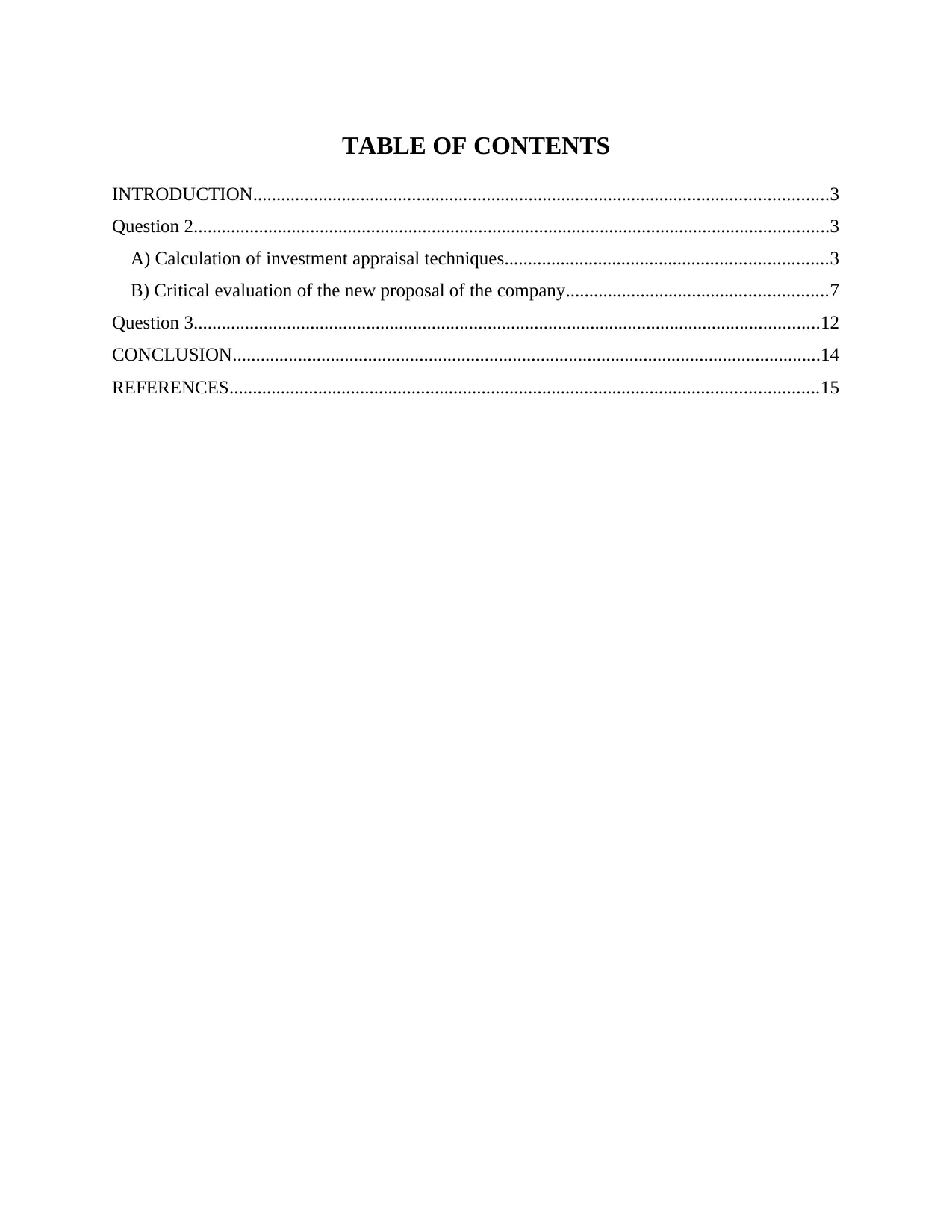
TABLE OF CONTENTS
INTRODUCTION...........................................................................................................................3
Question 2........................................................................................................................................3
A) Calculation of investment appraisal techniques.....................................................................3
B) Critical evaluation of the new proposal of the company........................................................7
Question 3......................................................................................................................................12
CONCLUSION..............................................................................................................................14
REFERENCES..............................................................................................................................15
INTRODUCTION...........................................................................................................................3
Question 2........................................................................................................................................3
A) Calculation of investment appraisal techniques.....................................................................3
B) Critical evaluation of the new proposal of the company........................................................7
Question 3......................................................................................................................................12
CONCLUSION..............................................................................................................................14
REFERENCES..............................................................................................................................15
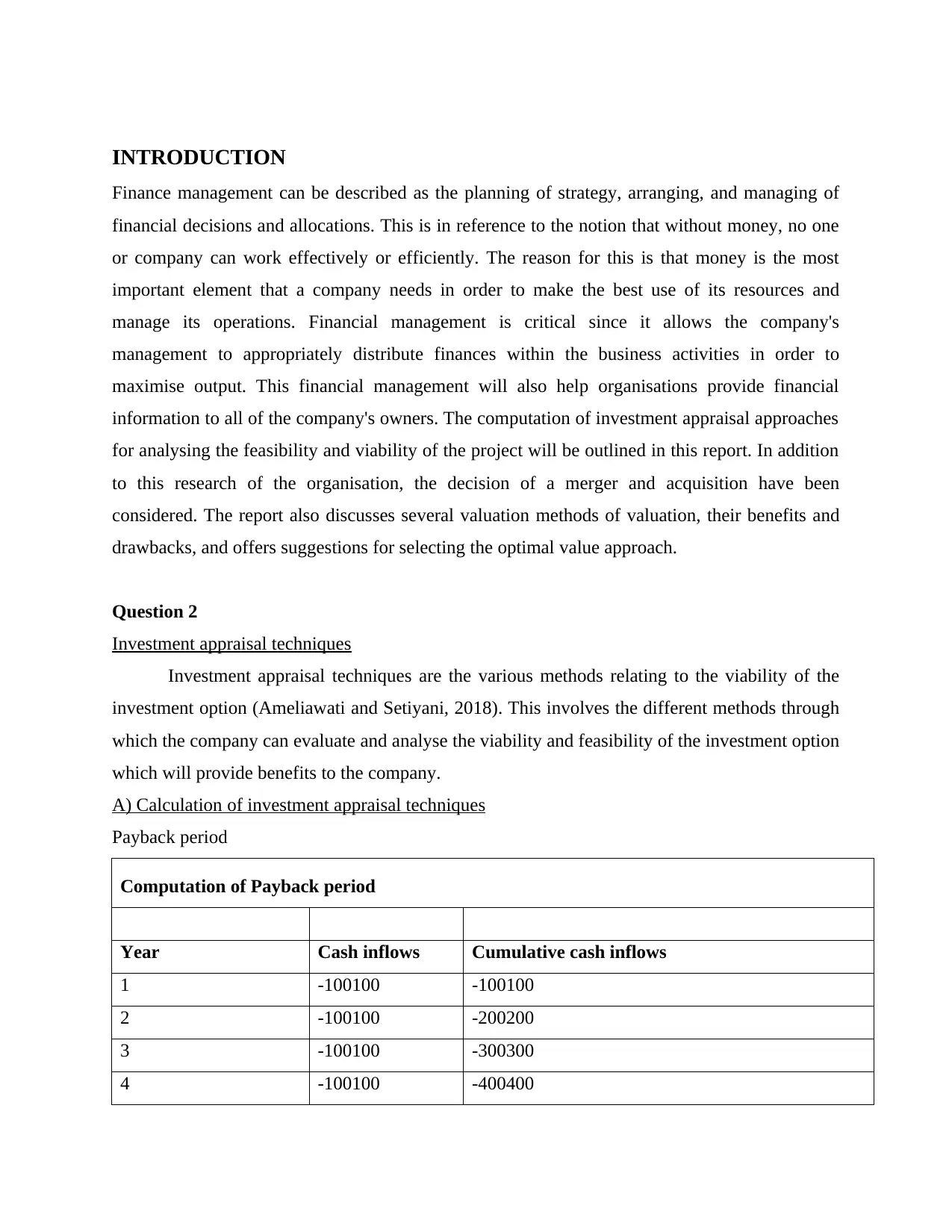
INTRODUCTION
Finance management can be described as the planning of strategy, arranging, and managing of
financial decisions and allocations. This is in reference to the notion that without money, no one
or company can work effectively or efficiently. The reason for this is that money is the most
important element that a company needs in order to make the best use of its resources and
manage its operations. Financial management is critical since it allows the company's
management to appropriately distribute finances within the business activities in order to
maximise output. This financial management will also help organisations provide financial
information to all of the company's owners. The computation of investment appraisal approaches
for analysing the feasibility and viability of the project will be outlined in this report. In addition
to this research of the organisation, the decision of a merger and acquisition have been
considered. The report also discusses several valuation methods of valuation, their benefits and
drawbacks, and offers suggestions for selecting the optimal value approach.
Question 2
Investment appraisal techniques
Investment appraisal techniques are the various methods relating to the viability of the
investment option (Ameliawati and Setiyani, 2018). This involves the different methods through
which the company can evaluate and analyse the viability and feasibility of the investment option
which will provide benefits to the company.
A) Calculation of investment appraisal techniques
Payback period
Computation of Payback period
Year Cash inflows Cumulative cash inflows
1 -100100 -100100
2 -100100 -200200
3 -100100 -300300
4 -100100 -400400
Finance management can be described as the planning of strategy, arranging, and managing of
financial decisions and allocations. This is in reference to the notion that without money, no one
or company can work effectively or efficiently. The reason for this is that money is the most
important element that a company needs in order to make the best use of its resources and
manage its operations. Financial management is critical since it allows the company's
management to appropriately distribute finances within the business activities in order to
maximise output. This financial management will also help organisations provide financial
information to all of the company's owners. The computation of investment appraisal approaches
for analysing the feasibility and viability of the project will be outlined in this report. In addition
to this research of the organisation, the decision of a merger and acquisition have been
considered. The report also discusses several valuation methods of valuation, their benefits and
drawbacks, and offers suggestions for selecting the optimal value approach.
Question 2
Investment appraisal techniques
Investment appraisal techniques are the various methods relating to the viability of the
investment option (Ameliawati and Setiyani, 2018). This involves the different methods through
which the company can evaluate and analyse the viability and feasibility of the investment option
which will provide benefits to the company.
A) Calculation of investment appraisal techniques
Payback period
Computation of Payback period
Year Cash inflows Cumulative cash inflows
1 -100100 -100100
2 -100100 -200200
3 -100100 -300300
4 -100100 -400400
⊘ This is a preview!⊘
Do you want full access?
Subscribe today to unlock all pages.

Trusted by 1+ million students worldwide
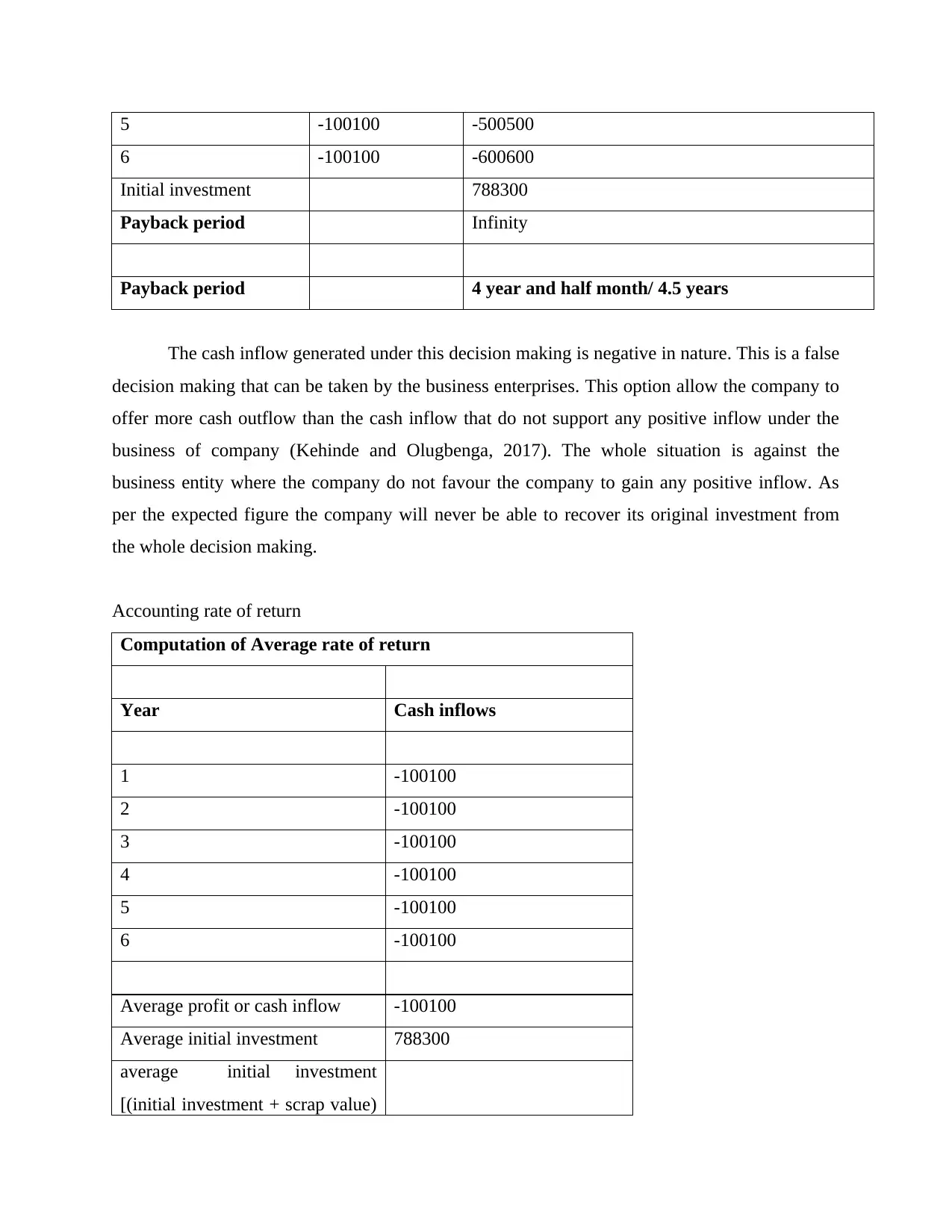
5 -100100 -500500
6 -100100 -600600
Initial investment 788300
Payback period Infinity
Payback period 4 year and half month/ 4.5 years
The cash inflow generated under this decision making is negative in nature. This is a false
decision making that can be taken by the business enterprises. This option allow the company to
offer more cash outflow than the cash inflow that do not support any positive inflow under the
business of company (Kehinde and Olugbenga, 2017). The whole situation is against the
business entity where the company do not favour the company to gain any positive inflow. As
per the expected figure the company will never be able to recover its original investment from
the whole decision making.
Accounting rate of return
Computation of Average rate of return
Year Cash inflows
1 -100100
2 -100100
3 -100100
4 -100100
5 -100100
6 -100100
Average profit or cash inflow -100100
Average initial investment 788300
average initial investment
[(initial investment + scrap value)
6 -100100 -600600
Initial investment 788300
Payback period Infinity
Payback period 4 year and half month/ 4.5 years
The cash inflow generated under this decision making is negative in nature. This is a false
decision making that can be taken by the business enterprises. This option allow the company to
offer more cash outflow than the cash inflow that do not support any positive inflow under the
business of company (Kehinde and Olugbenga, 2017). The whole situation is against the
business entity where the company do not favour the company to gain any positive inflow. As
per the expected figure the company will never be able to recover its original investment from
the whole decision making.
Accounting rate of return
Computation of Average rate of return
Year Cash inflows
1 -100100
2 -100100
3 -100100
4 -100100
5 -100100
6 -100100
Average profit or cash inflow -100100
Average initial investment 788300
average initial investment
[(initial investment + scrap value)
Paraphrase This Document
Need a fresh take? Get an instant paraphrase of this document with our AI Paraphraser
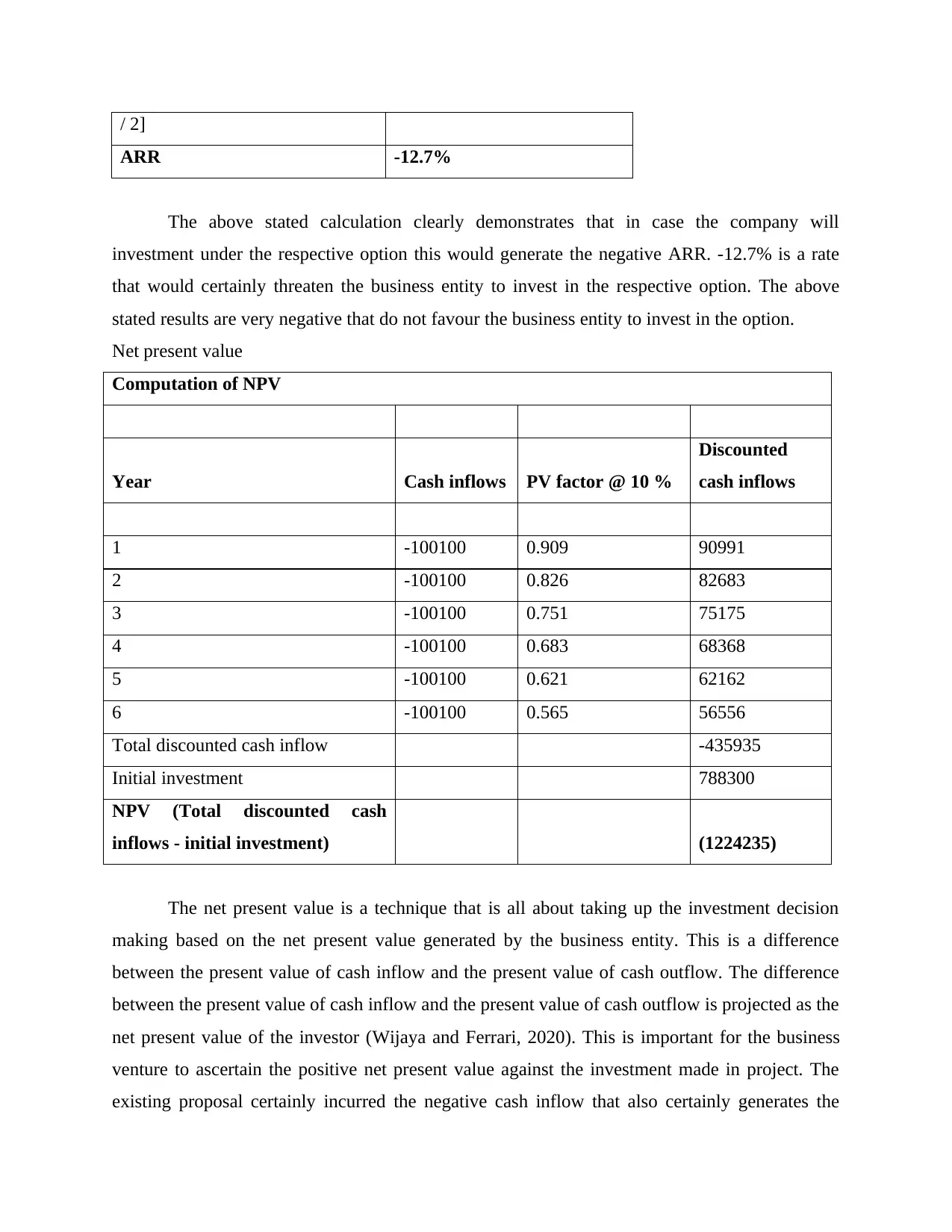
/ 2]
ARR -12.7%
The above stated calculation clearly demonstrates that in case the company will
investment under the respective option this would generate the negative ARR. -12.7% is a rate
that would certainly threaten the business entity to invest in the respective option. The above
stated results are very negative that do not favour the business entity to invest in the option.
Net present value
Computation of NPV
Year Cash inflows PV factor @ 10 %
Discounted
cash inflows
1 -100100 0.909 90991
2 -100100 0.826 82683
3 -100100 0.751 75175
4 -100100 0.683 68368
5 -100100 0.621 62162
6 -100100 0.565 56556
Total discounted cash inflow -435935
Initial investment 788300
NPV (Total discounted cash
inflows - initial investment) (1224235)
The net present value is a technique that is all about taking up the investment decision
making based on the net present value generated by the business entity. This is a difference
between the present value of cash inflow and the present value of cash outflow. The difference
between the present value of cash inflow and the present value of cash outflow is projected as the
net present value of the investor (Wijaya and Ferrari, 2020). This is important for the business
venture to ascertain the positive net present value against the investment made in project. The
existing proposal certainly incurred the negative cash inflow that also certainly generates the
ARR -12.7%
The above stated calculation clearly demonstrates that in case the company will
investment under the respective option this would generate the negative ARR. -12.7% is a rate
that would certainly threaten the business entity to invest in the respective option. The above
stated results are very negative that do not favour the business entity to invest in the option.
Net present value
Computation of NPV
Year Cash inflows PV factor @ 10 %
Discounted
cash inflows
1 -100100 0.909 90991
2 -100100 0.826 82683
3 -100100 0.751 75175
4 -100100 0.683 68368
5 -100100 0.621 62162
6 -100100 0.565 56556
Total discounted cash inflow -435935
Initial investment 788300
NPV (Total discounted cash
inflows - initial investment) (1224235)
The net present value is a technique that is all about taking up the investment decision
making based on the net present value generated by the business entity. This is a difference
between the present value of cash inflow and the present value of cash outflow. The difference
between the present value of cash inflow and the present value of cash outflow is projected as the
net present value of the investor (Wijaya and Ferrari, 2020). This is important for the business
venture to ascertain the positive net present value against the investment made in project. The
existing proposal certainly incurred the negative cash inflow that also certainly generates the
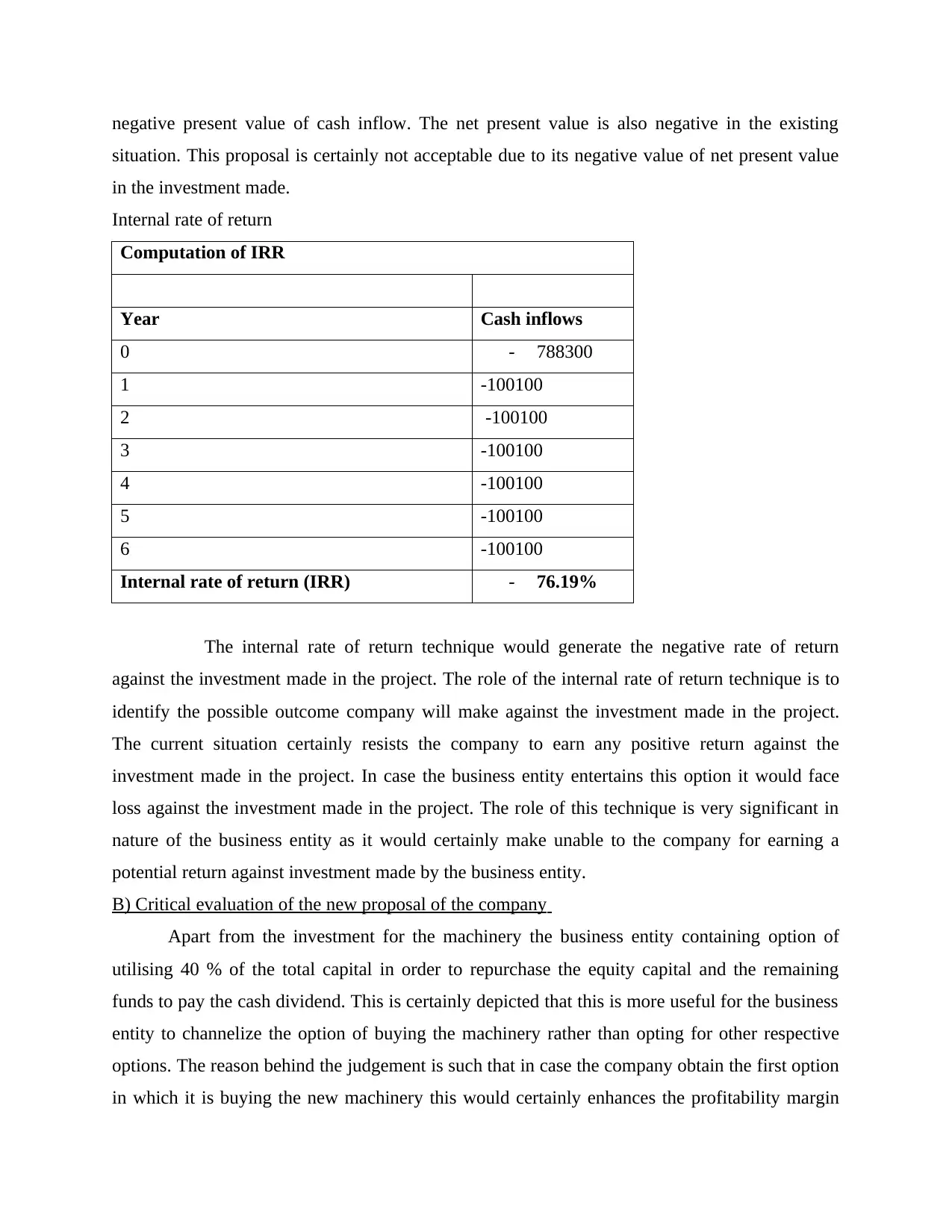
negative present value of cash inflow. The net present value is also negative in the existing
situation. This proposal is certainly not acceptable due to its negative value of net present value
in the investment made.
Internal rate of return
Computation of IRR
Year Cash inflows
0 - 788300
1 -100100
2 -100100
3 -100100
4 -100100
5 -100100
6 -100100
Internal rate of return (IRR) - 76.19%
The internal rate of return technique would generate the negative rate of return
against the investment made in the project. The role of the internal rate of return technique is to
identify the possible outcome company will make against the investment made in the project.
The current situation certainly resists the company to earn any positive return against the
investment made in the project. In case the business entity entertains this option it would face
loss against the investment made in the project. The role of this technique is very significant in
nature of the business entity as it would certainly make unable to the company for earning a
potential return against investment made by the business entity.
B) Critical evaluation of the new proposal of the company
Apart from the investment for the machinery the business entity containing option of
utilising 40 % of the total capital in order to repurchase the equity capital and the remaining
funds to pay the cash dividend. This is certainly depicted that this is more useful for the business
entity to channelize the option of buying the machinery rather than opting for other respective
options. The reason behind the judgement is such that in case the company obtain the first option
in which it is buying the new machinery this would certainly enhances the profitability margin
situation. This proposal is certainly not acceptable due to its negative value of net present value
in the investment made.
Internal rate of return
Computation of IRR
Year Cash inflows
0 - 788300
1 -100100
2 -100100
3 -100100
4 -100100
5 -100100
6 -100100
Internal rate of return (IRR) - 76.19%
The internal rate of return technique would generate the negative rate of return
against the investment made in the project. The role of the internal rate of return technique is to
identify the possible outcome company will make against the investment made in the project.
The current situation certainly resists the company to earn any positive return against the
investment made in the project. In case the business entity entertains this option it would face
loss against the investment made in the project. The role of this technique is very significant in
nature of the business entity as it would certainly make unable to the company for earning a
potential return against investment made by the business entity.
B) Critical evaluation of the new proposal of the company
Apart from the investment for the machinery the business entity containing option of
utilising 40 % of the total capital in order to repurchase the equity capital and the remaining
funds to pay the cash dividend. This is certainly depicted that this is more useful for the business
entity to channelize the option of buying the machinery rather than opting for other respective
options. The reason behind the judgement is such that in case the company obtain the first option
in which it is buying the new machinery this would certainly enhances the profitability margin
⊘ This is a preview!⊘
Do you want full access?
Subscribe today to unlock all pages.

Trusted by 1+ million students worldwide
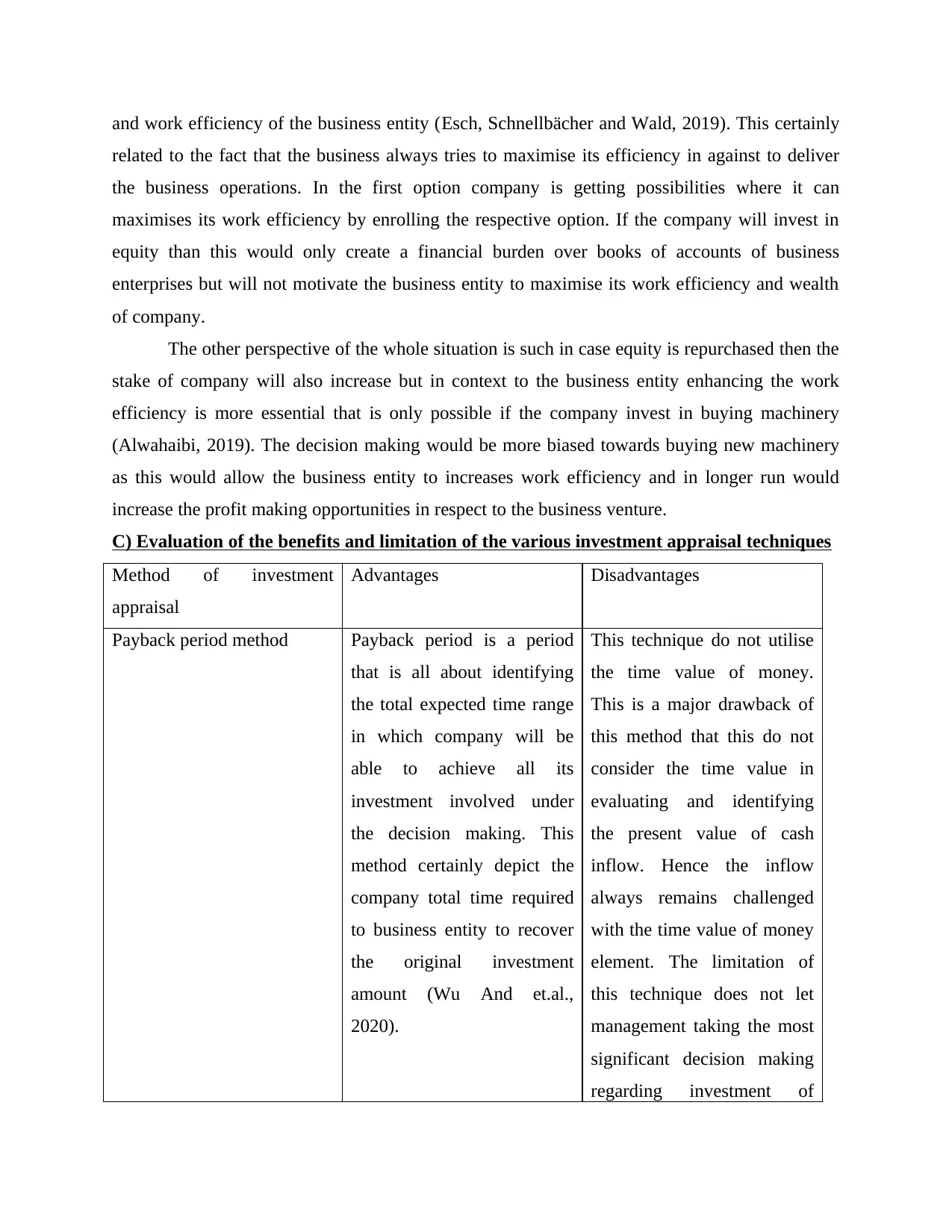
and work efficiency of the business entity (Esch, Schnellbächer and Wald, 2019). This certainly
related to the fact that the business always tries to maximise its efficiency in against to deliver
the business operations. In the first option company is getting possibilities where it can
maximises its work efficiency by enrolling the respective option. If the company will invest in
equity than this would only create a financial burden over books of accounts of business
enterprises but will not motivate the business entity to maximise its work efficiency and wealth
of company.
The other perspective of the whole situation is such in case equity is repurchased then the
stake of company will also increase but in context to the business entity enhancing the work
efficiency is more essential that is only possible if the company invest in buying machinery
(Alwahaibi, 2019). The decision making would be more biased towards buying new machinery
as this would allow the business entity to increases work efficiency and in longer run would
increase the profit making opportunities in respect to the business venture.
C) Evaluation of the benefits and limitation of the various investment appraisal techniques
Method of investment
appraisal
Advantages Disadvantages
Payback period method Payback period is a period
that is all about identifying
the total expected time range
in which company will be
able to achieve all its
investment involved under
the decision making. This
method certainly depict the
company total time required
to business entity to recover
the original investment
amount (Wu And et.al.,
2020).
This technique do not utilise
the time value of money.
This is a major drawback of
this method that this do not
consider the time value in
evaluating and identifying
the present value of cash
inflow. Hence the inflow
always remains challenged
with the time value of money
element. The limitation of
this technique does not let
management taking the most
significant decision making
regarding investment of
related to the fact that the business always tries to maximise its efficiency in against to deliver
the business operations. In the first option company is getting possibilities where it can
maximises its work efficiency by enrolling the respective option. If the company will invest in
equity than this would only create a financial burden over books of accounts of business
enterprises but will not motivate the business entity to maximise its work efficiency and wealth
of company.
The other perspective of the whole situation is such in case equity is repurchased then the
stake of company will also increase but in context to the business entity enhancing the work
efficiency is more essential that is only possible if the company invest in buying machinery
(Alwahaibi, 2019). The decision making would be more biased towards buying new machinery
as this would allow the business entity to increases work efficiency and in longer run would
increase the profit making opportunities in respect to the business venture.
C) Evaluation of the benefits and limitation of the various investment appraisal techniques
Method of investment
appraisal
Advantages Disadvantages
Payback period method Payback period is a period
that is all about identifying
the total expected time range
in which company will be
able to achieve all its
investment involved under
the decision making. This
method certainly depict the
company total time required
to business entity to recover
the original investment
amount (Wu And et.al.,
2020).
This technique do not utilise
the time value of money.
This is a major drawback of
this method that this do not
consider the time value in
evaluating and identifying
the present value of cash
inflow. Hence the inflow
always remains challenged
with the time value of money
element. The limitation of
this technique does not let
management taking the most
significant decision making
regarding investment of
Paraphrase This Document
Need a fresh take? Get an instant paraphrase of this document with our AI Paraphraser
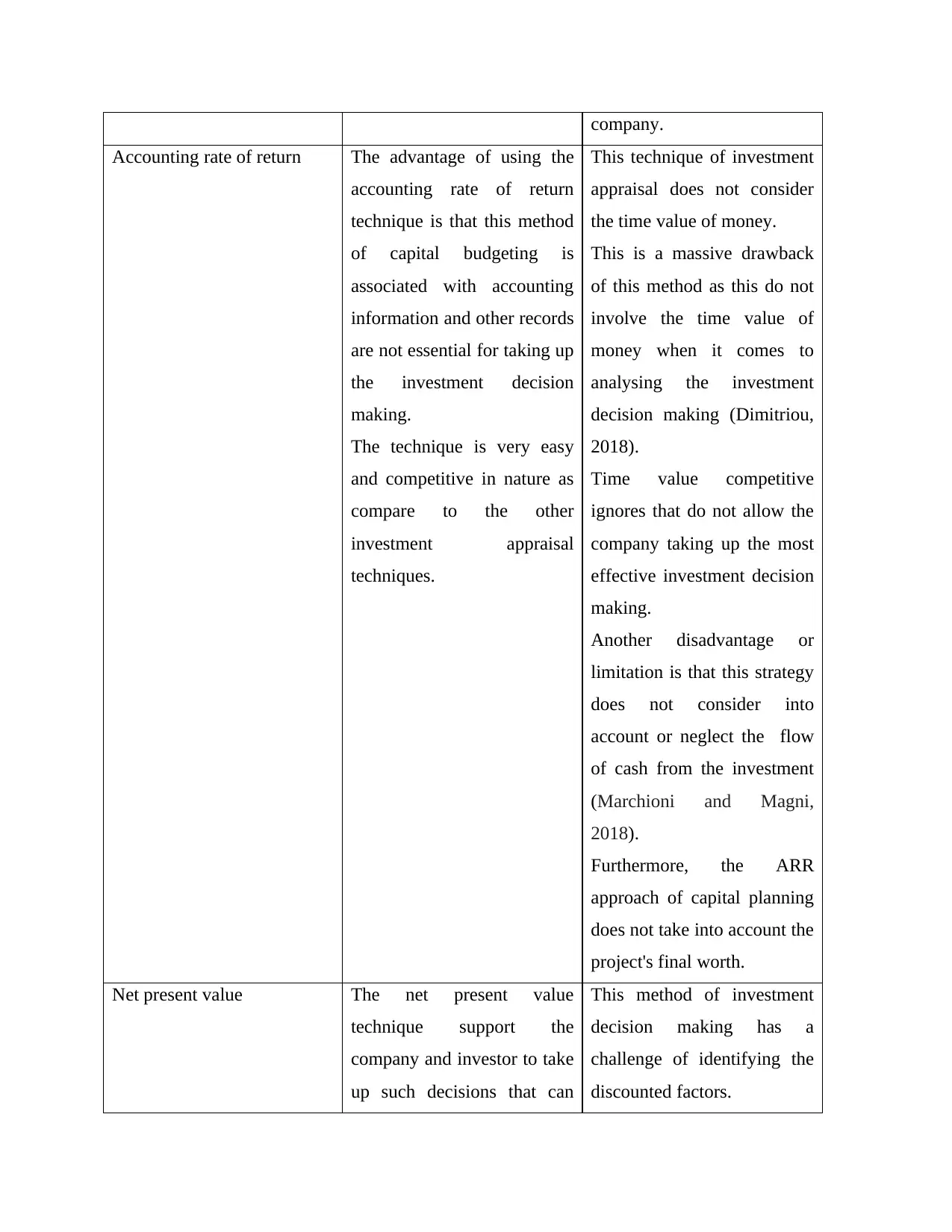
company.
Accounting rate of return The advantage of using the
accounting rate of return
technique is that this method
of capital budgeting is
associated with accounting
information and other records
are not essential for taking up
the investment decision
making.
The technique is very easy
and competitive in nature as
compare to the other
investment appraisal
techniques.
This technique of investment
appraisal does not consider
the time value of money.
This is a massive drawback
of this method as this do not
involve the time value of
money when it comes to
analysing the investment
decision making (Dimitriou,
2018).
Time value competitive
ignores that do not allow the
company taking up the most
effective investment decision
making.
Another disadvantage or
limitation is that this strategy
does not consider into
account or neglect the flow
of cash from the investment
(Marchioni and Magni,
2018).
Furthermore, the ARR
approach of capital planning
does not take into account the
project's final worth.
Net present value The net present value
technique support the
company and investor to take
up such decisions that can
This method of investment
decision making has a
challenge of identifying the
discounted factors.
Accounting rate of return The advantage of using the
accounting rate of return
technique is that this method
of capital budgeting is
associated with accounting
information and other records
are not essential for taking up
the investment decision
making.
The technique is very easy
and competitive in nature as
compare to the other
investment appraisal
techniques.
This technique of investment
appraisal does not consider
the time value of money.
This is a massive drawback
of this method as this do not
involve the time value of
money when it comes to
analysing the investment
decision making (Dimitriou,
2018).
Time value competitive
ignores that do not allow the
company taking up the most
effective investment decision
making.
Another disadvantage or
limitation is that this strategy
does not consider into
account or neglect the flow
of cash from the investment
(Marchioni and Magni,
2018).
Furthermore, the ARR
approach of capital planning
does not take into account the
project's final worth.
Net present value The net present value
technique support the
company and investor to take
up such decisions that can
This method of investment
decision making has a
challenge of identifying the
discounted factors.
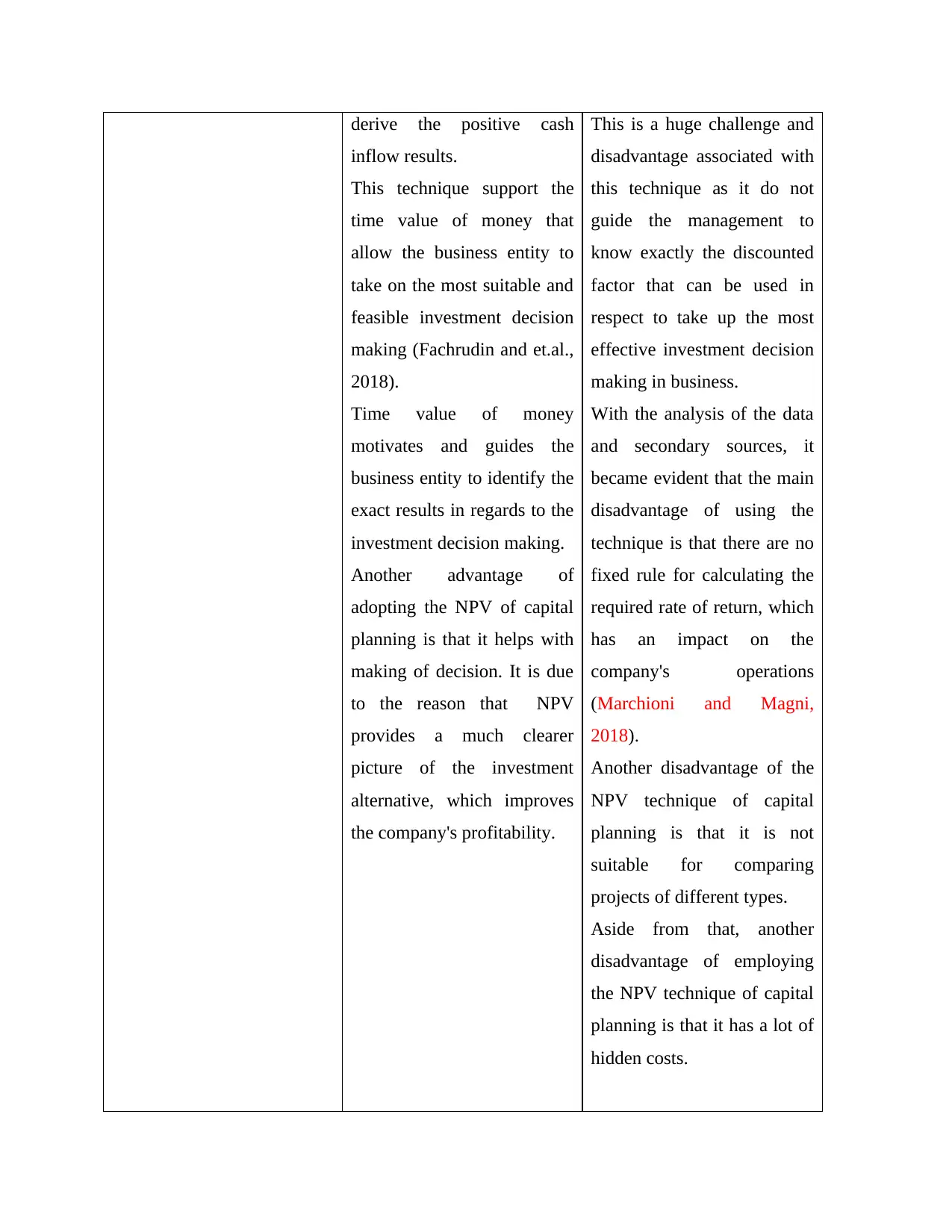
derive the positive cash
inflow results.
This technique support the
time value of money that
allow the business entity to
take on the most suitable and
feasible investment decision
making (Fachrudin and et.al.,
2018).
Time value of money
motivates and guides the
business entity to identify the
exact results in regards to the
investment decision making.
Another advantage of
adopting the NPV of capital
planning is that it helps with
making of decision. It is due
to the reason that NPV
provides a much clearer
picture of the investment
alternative, which improves
the company's profitability.
This is a huge challenge and
disadvantage associated with
this technique as it do not
guide the management to
know exactly the discounted
factor that can be used in
respect to take up the most
effective investment decision
making in business.
With the analysis of the data
and secondary sources, it
became evident that the main
disadvantage of using the
technique is that there are no
fixed rule for calculating the
required rate of return, which
has an impact on the
company's operations
(Marchioni and Magni,
2018).
Another disadvantage of the
NPV technique of capital
planning is that it is not
suitable for comparing
projects of different types.
Aside from that, another
disadvantage of employing
the NPV technique of capital
planning is that it has a lot of
hidden costs.
inflow results.
This technique support the
time value of money that
allow the business entity to
take on the most suitable and
feasible investment decision
making (Fachrudin and et.al.,
2018).
Time value of money
motivates and guides the
business entity to identify the
exact results in regards to the
investment decision making.
Another advantage of
adopting the NPV of capital
planning is that it helps with
making of decision. It is due
to the reason that NPV
provides a much clearer
picture of the investment
alternative, which improves
the company's profitability.
This is a huge challenge and
disadvantage associated with
this technique as it do not
guide the management to
know exactly the discounted
factor that can be used in
respect to take up the most
effective investment decision
making in business.
With the analysis of the data
and secondary sources, it
became evident that the main
disadvantage of using the
technique is that there are no
fixed rule for calculating the
required rate of return, which
has an impact on the
company's operations
(Marchioni and Magni,
2018).
Another disadvantage of the
NPV technique of capital
planning is that it is not
suitable for comparing
projects of different types.
Aside from that, another
disadvantage of employing
the NPV technique of capital
planning is that it has a lot of
hidden costs.
⊘ This is a preview!⊘
Do you want full access?
Subscribe today to unlock all pages.

Trusted by 1+ million students worldwide
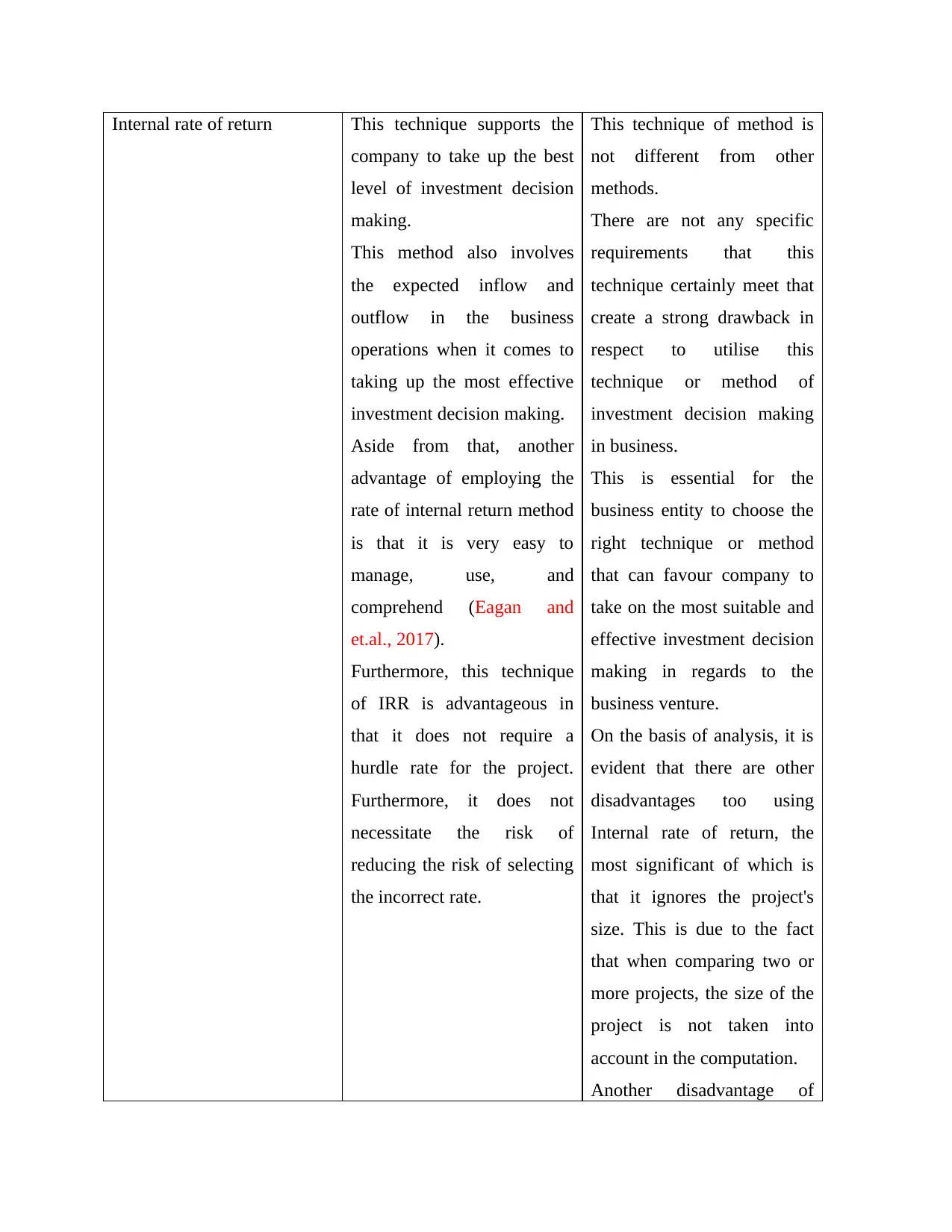
Internal rate of return This technique supports the
company to take up the best
level of investment decision
making.
This method also involves
the expected inflow and
outflow in the business
operations when it comes to
taking up the most effective
investment decision making.
Aside from that, another
advantage of employing the
rate of internal return method
is that it is very easy to
manage, use, and
comprehend (Eagan and
et.al., 2017).
Furthermore, this technique
of IRR is advantageous in
that it does not require a
hurdle rate for the project.
Furthermore, it does not
necessitate the risk of
reducing the risk of selecting
the incorrect rate.
This technique of method is
not different from other
methods.
There are not any specific
requirements that this
technique certainly meet that
create a strong drawback in
respect to utilise this
technique or method of
investment decision making
in business.
This is essential for the
business entity to choose the
right technique or method
that can favour company to
take on the most suitable and
effective investment decision
making in regards to the
business venture.
On the basis of analysis, it is
evident that there are other
disadvantages too using
Internal rate of return, the
most significant of which is
that it ignores the project's
size. This is due to the fact
that when comparing two or
more projects, the size of the
project is not taken into
account in the computation.
Another disadvantage of
company to take up the best
level of investment decision
making.
This method also involves
the expected inflow and
outflow in the business
operations when it comes to
taking up the most effective
investment decision making.
Aside from that, another
advantage of employing the
rate of internal return method
is that it is very easy to
manage, use, and
comprehend (Eagan and
et.al., 2017).
Furthermore, this technique
of IRR is advantageous in
that it does not require a
hurdle rate for the project.
Furthermore, it does not
necessitate the risk of
reducing the risk of selecting
the incorrect rate.
This technique of method is
not different from other
methods.
There are not any specific
requirements that this
technique certainly meet that
create a strong drawback in
respect to utilise this
technique or method of
investment decision making
in business.
This is essential for the
business entity to choose the
right technique or method
that can favour company to
take on the most suitable and
effective investment decision
making in regards to the
business venture.
On the basis of analysis, it is
evident that there are other
disadvantages too using
Internal rate of return, the
most significant of which is
that it ignores the project's
size. This is due to the fact
that when comparing two or
more projects, the size of the
project is not taken into
account in the computation.
Another disadvantage of
Paraphrase This Document
Need a fresh take? Get an instant paraphrase of this document with our AI Paraphraser
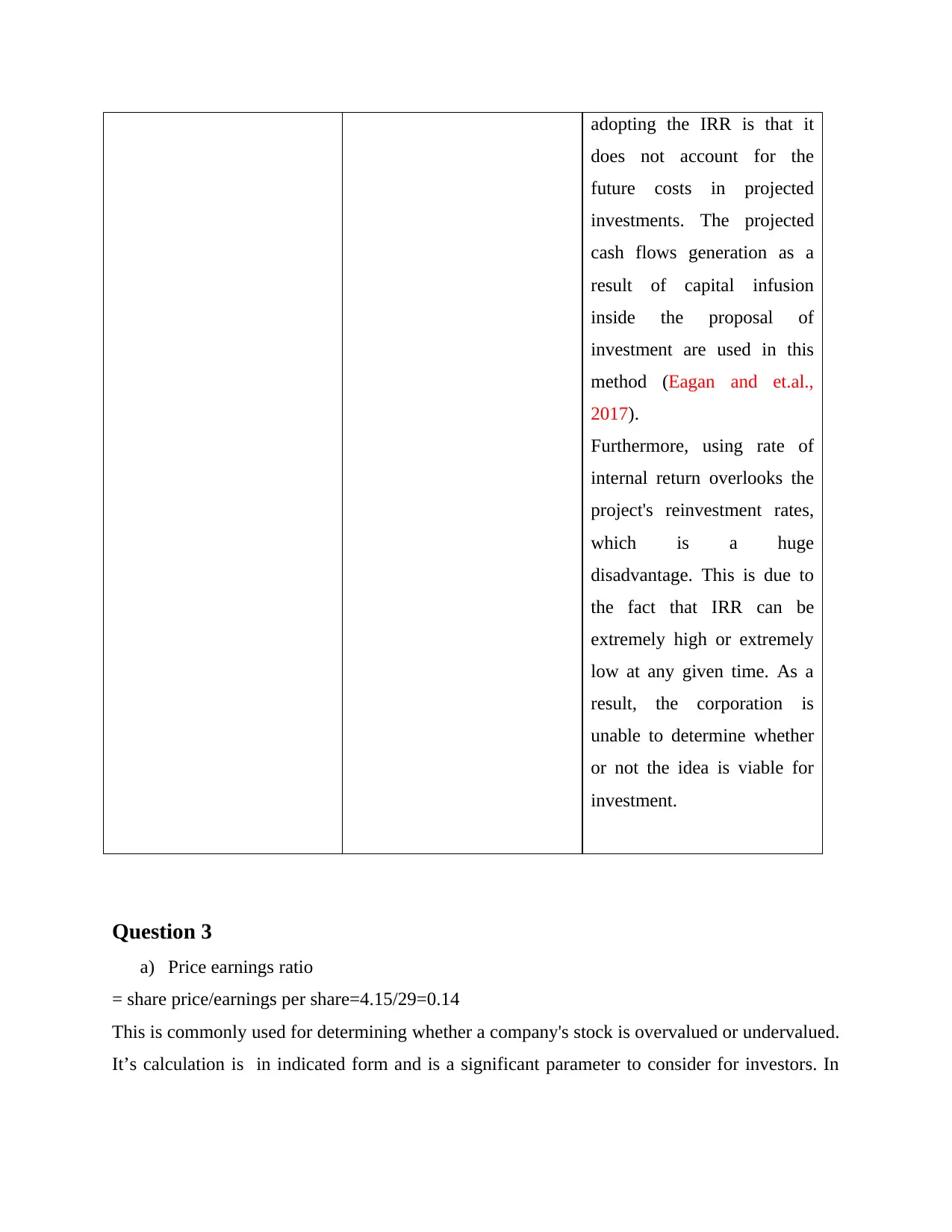
adopting the IRR is that it
does not account for the
future costs in projected
investments. The projected
cash flows generation as a
result of capital infusion
inside the proposal of
investment are used in this
method (Eagan and et.al.,
2017).
Furthermore, using rate of
internal return overlooks the
project's reinvestment rates,
which is a huge
disadvantage. This is due to
the fact that IRR can be
extremely high or extremely
low at any given time. As a
result, the corporation is
unable to determine whether
or not the idea is viable for
investment.
Question 3
a) Price earnings ratio
= share price/earnings per share=4.15/29=0.14
This is commonly used for determining whether a company's stock is overvalued or undervalued.
It’s calculation is in indicated form and is a significant parameter to consider for investors. In
does not account for the
future costs in projected
investments. The projected
cash flows generation as a
result of capital infusion
inside the proposal of
investment are used in this
method (Eagan and et.al.,
2017).
Furthermore, using rate of
internal return overlooks the
project's reinvestment rates,
which is a huge
disadvantage. This is due to
the fact that IRR can be
extremely high or extremely
low at any given time. As a
result, the corporation is
unable to determine whether
or not the idea is viable for
investment.
Question 3
a) Price earnings ratio
= share price/earnings per share=4.15/29=0.14
This is commonly used for determining whether a company's stock is overvalued or undervalued.
It’s calculation is in indicated form and is a significant parameter to consider for investors. In
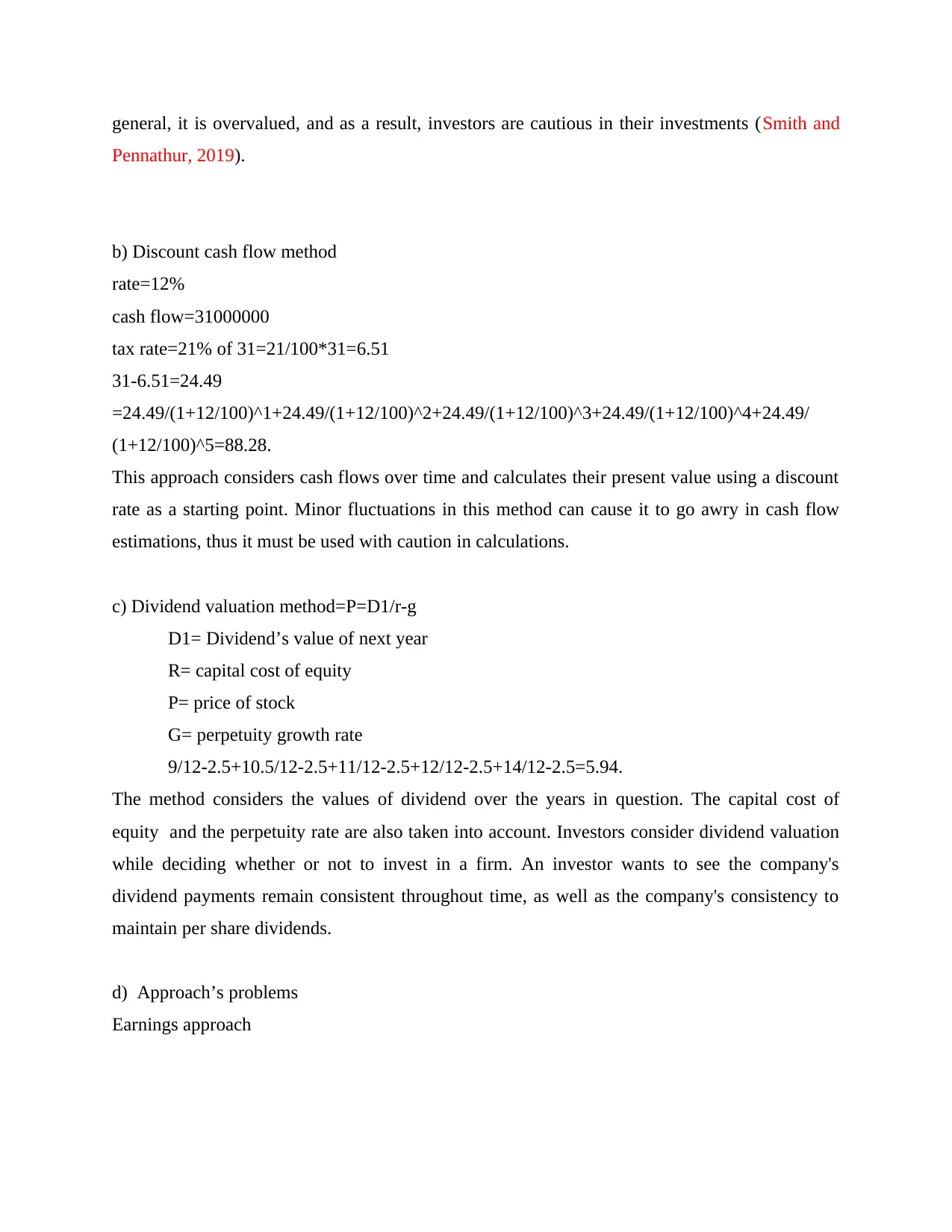
general, it is overvalued, and as a result, investors are cautious in their investments (Smith and
Pennathur, 2019).
b) Discount cash flow method
rate=12%
cash flow=31000000
tax rate=21% of 31=21/100*31=6.51
31-6.51=24.49
=24.49/(1+12/100)^1+24.49/(1+12/100)^2+24.49/(1+12/100)^3+24.49/(1+12/100)^4+24.49/
(1+12/100)^5=88.28.
This approach considers cash flows over time and calculates their present value using a discount
rate as a starting point. Minor fluctuations in this method can cause it to go awry in cash flow
estimations, thus it must be used with caution in calculations.
c) Dividend valuation method=P=D1/r-g
D1= Dividend’s value of next year
R= capital cost of equity
P= price of stock
G= perpetuity growth rate
9/12-2.5+10.5/12-2.5+11/12-2.5+12/12-2.5+14/12-2.5=5.94.
The method considers the values of dividend over the years in question. The capital cost of
equity and the perpetuity rate are also taken into account. Investors consider dividend valuation
while deciding whether or not to invest in a firm. An investor wants to see the company's
dividend payments remain consistent throughout time, as well as the company's consistency to
maintain per share dividends.
d) Approach’s problems
Earnings approach
Pennathur, 2019).
b) Discount cash flow method
rate=12%
cash flow=31000000
tax rate=21% of 31=21/100*31=6.51
31-6.51=24.49
=24.49/(1+12/100)^1+24.49/(1+12/100)^2+24.49/(1+12/100)^3+24.49/(1+12/100)^4+24.49/
(1+12/100)^5=88.28.
This approach considers cash flows over time and calculates their present value using a discount
rate as a starting point. Minor fluctuations in this method can cause it to go awry in cash flow
estimations, thus it must be used with caution in calculations.
c) Dividend valuation method=P=D1/r-g
D1= Dividend’s value of next year
R= capital cost of equity
P= price of stock
G= perpetuity growth rate
9/12-2.5+10.5/12-2.5+11/12-2.5+12/12-2.5+14/12-2.5=5.94.
The method considers the values of dividend over the years in question. The capital cost of
equity and the perpetuity rate are also taken into account. Investors consider dividend valuation
while deciding whether or not to invest in a firm. An investor wants to see the company's
dividend payments remain consistent throughout time, as well as the company's consistency to
maintain per share dividends.
d) Approach’s problems
Earnings approach
⊘ This is a preview!⊘
Do you want full access?
Subscribe today to unlock all pages.

Trusted by 1+ million students worldwide
1 out of 26
Related Documents
Your All-in-One AI-Powered Toolkit for Academic Success.
+13062052269
info@desklib.com
Available 24*7 on WhatsApp / Email
![[object Object]](/_next/static/media/star-bottom.7253800d.svg)
Unlock your academic potential
Copyright © 2020–2025 A2Z Services. All Rights Reserved. Developed and managed by ZUCOL.





